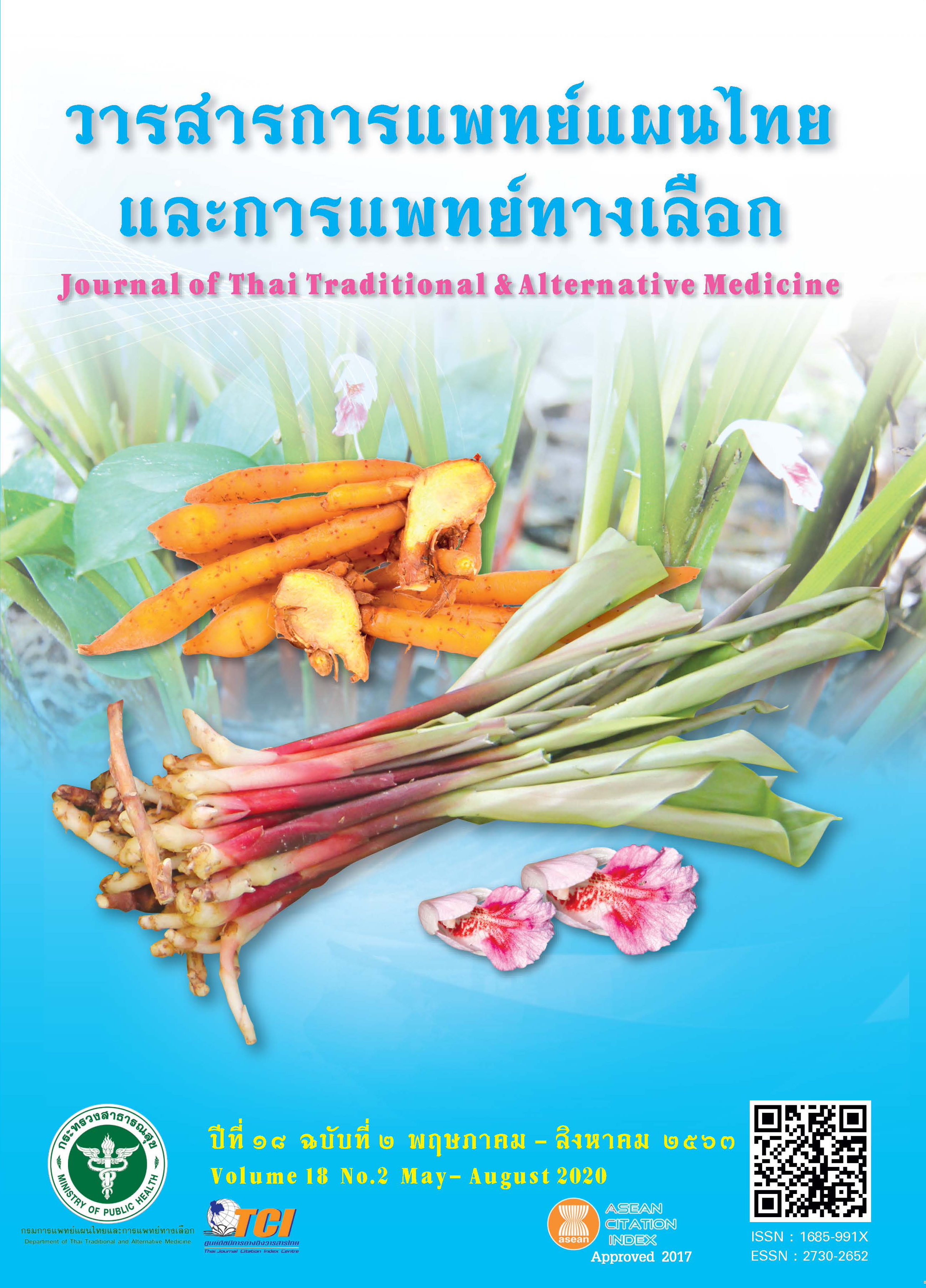Bioactivity Study of Tadehagi triquetrum (L.) H. Extracts Used in Thai Folk Medicine
Main Article Content
Abstract
Tadehagi triquetrum (L.) H. is a medicinal plant that has traditionally been used as an antimicrobial agent for extending the expiration date of products containing water as vehicle. Thai folk medicine practitioners have also used a decoction of T. triquetrum leaves for improving physical and sexual performances in men. The aim of our study was to determine the bioactivity of T. triquetrum extracts using different polar and nonpolar solvents. We evaluated the antioxidant activity of extracts using DPPH and ABTS assays. We investigated phosphodiesterase-5 (PDE-5) inhibitory activity of the extracts, which is associated with enhancing sexual and physical performance. We measured antimicrobial activity of the extracts using disc diffusion and minimal inhibitory concentration (MIC). The results revealed that the ethanolic and water extracts showed potent antioxidant and antimicrobial activities. Water extract presented the highest antioxidant activity (IC50 = 12.45 ± 0.14 µg/mL). Polar extracts inhibited the growth of microorganisms S. aureus, E. coli and Ps. Aeruginosa. The non-polar extract effectively suppressed fungal growth. Interestingly, the Thai folk medicine formulation of T. triquetrum water extract at 50 µg/mL inhibited PDE-5 activity by 60.45% (SD = 0.14). This level of inhibition is considered good bioactivity. As these findings are promising, future in vitro, in vivo, and clinical studies should be conducted to examine properties of this plant in greater detail.
Article Details
References
Vedpal D, Jayaram U, Wadhwani A, Dhanabal SP. Isolation and characterization of flavonoids from the roots of medicinal plant Tadehagi triquetrum (L.) H.Ohashi. Nat Prod Res. 2019:1-6.
Satean G, Homhuan S, Premprasit S. Plant utilization from Thungluilai community forest in Thungluilai sub-district, Kornsarn district, Chaiyaphum Province. Journal of Social Sciences. 2018;14(2):211-45. (in Thai)
Libman A, Bouamanivong S, Southavong B, Sydara K, Soejarto DD. Medicinal plants: an important asset to health care in a region of Central Laos. J Ethnopharmacol. 2006;106(3):303-11.
Community forest management office. 60 Local wisdom: Herb in community forest. Boonyanun N, editor. Bangkok: Royal Forest Department; 2015. 133 p. (in Thai)
Temkifthawon P, Changwichit K, Khorana N, Viyoch J, Suwanborirux K, Ingkaninan K. Phenanthrenes from Eulophia macrobulbon as novel phosphodiesterase-5 inhibitors. Nat Prod Commun. 2017;12(1):79-82.
Yan X, Xie G, Zhou J, Milne GWA. Traditional Chinese Medicines: Molecular Structures, Natural Sources and Applications. 2 ed. New York: Ashgate Publishing; 2003.
Rakkhaoyai. Ya Tarn Kor Ma. [Internet]. 2013 [cited: 2019 Aug 20]; Available from: http://www.rakkhaoyai.com/jungle-path/3308. (in Thai)
DeFilipps RA, Krupnick GA. The medicinal plants of Myanmar. Phytokeys. 2018;102:143-4.
Aye MM, Aung HT, Sein MM, Armijos C. A review on the phytochemistry, medicinal properties and pharmacological activities of 15 selected Myanmar medicinal plants. Molecules. 2019;24:293.
Boer HJd, Vongsombath C, Käfer J. A fly in the ointment: Evaluation of traditional use of plants to repel and kill blowfly larvae in fermented fish. PLoS One. 2011;6(12): e29521.
Zhang R-T, Cheng G-G, Feng T, Cai X-H, Luo X-D. Four new isoflavanones from Tadehagi triquetrum. Nat Prod Bioprospect. 2011;1(3):121-3.
Wu J, Zhang Cy, Zhang T, Zhao D, An N, Li Y, Zhu N, Wang S, Chen F, Zhang X. A new lignan with hypoglycemic activity from Tadehagi triquetrum. Nat Prod Res. 2015;29(18):1723-7.
Zhang X, Chen C, Li Y, Chen D, Dong L, Na W, Wu C, Zhang J, Li Y. Tadehaginosides A–J, phenylpropanoid glucosides from Tadehagi triquetrum, enhance glucose uptake via the upregulation of PPARγ and GLUT-4 in C2C12 myotubes. J Nat Prod. 2016;79(5):1249-58.
Huang SA, Lie JD. Phosphodiesterase-5 (PDE5) inhibitors in the management of erectile dysfunction. P T. 2013;38(7): 407,414-9.
Stockert JC, Blázquez-Castro A, Cañete M, Horobin RW, Villanueva A. MTT assay for cell viability: Intracellular localization of the formazan product is in lipid droplets. Acta Histochem. 2012;114(8):785–96.
Thaipong K, Boonprakob U, Crosby K, Cisneros-Zevallos L, Byrne DH. Comparison of ABTS, DPPH, FRAP, and ORAC assays for estimating antioxidant activity from guava fruit extracts. J Food Compos Anal. 2006;19(6-7):669-75.
Chit K, Myint W, Thein K, Maw WW, Myint MM, Than A, Khin M. Cyclic AMP phosphodiesterase inhibitory activity and chemical screening of four medicinal plants. Pharmaceutical Biology. 2001;39(3):181-3.
Temkitthawon P, Hinds TR, Beavo JA, Viyoch J, Suwanborirux K, Pongamornkul W, Sawasdee P, Ingkaninan K. Kaempferia parviflora, a plant used in traditional medicine to enhance sexual performance contains large amounts of low affinity PDE5 inhibitors. J Ethnopharmacol. 2011;137(3):1437-41.
Rybalkin SD, Rybalkina IG, Shimizu-Albergine M, Tang X-B, Beavo JA. PDE5 is converted to an activated state upon cGMP binding to the GAF A domain. Embo J. 2003;22(3):469-78.
Luigi LD, Sansone M, Sansone A, Ceci R, Duranti G, Borrione P, Crescioli C, Sgrò P, Sabatini S. Phosphodiesterase type 5 inhibitors, sport and doping. Curr Sports Med Rep. 2017;16(6):443-7.
Kalam S, Singh R, Mani A, Patel J, Khan FN, Pandey A. Antioxidants: Elixir of life. International Multidisciplinary Research Journal. 2012;2(1):18-34.
Liochev SI. Reactive oxygen species and the free radical theory of aging. Free Radic Biol Med. 2013;60:1-4.
Kehrer JP, Klotz LO. Free radicals and related reactive species as mediators of tissue injury and disease: Implications for health. Crit Rev in Toxicol. 2015;45(9):765-98.
Tang A, Chen X, Lu Q, Zheng N, Wei Y, Wu X. Antihepatotoxic effect of Tadehaginoside, extracted from Tadehagi triquetrum (L.), against CCl4-lesioned rats through activating the Nrf2 signaling pathway and attenuating the inflammatory response. Inflammation. 2014;37(4):1006-14.
Lwin HS, M T. Effect of Desmodium triquetrum extract on some pathogenic bacteria. Union of Burma Journal of Life Sciences. 1968;50(1):66-70.


